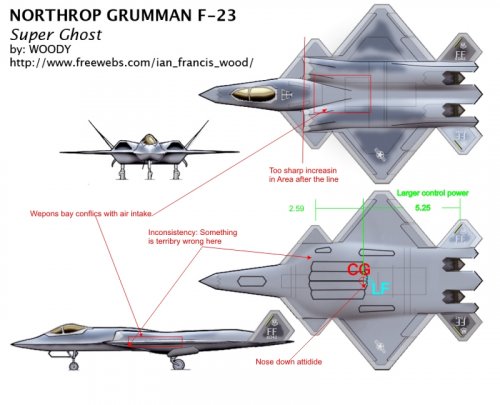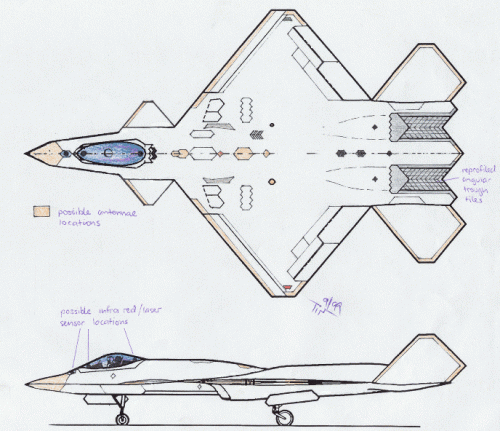lantinian
ACCESS: Top Secret
- Joined
- 24 March 2007
- Messages
- 538
- Reaction score
- 169
Hey woody,
Check the underside of your airplane against the side view. The weapons bay doors will have to be massively bent and you your bay depth will be almost null in its forward part.
You also don’t seam to have paid attention to area rooling which contributes to wave drag: the most important principle in supersonic flight. Your F-23 mockery may not be able to fly supersonically
Also close coupling the canard to the wing will affect the lift over the wing and possibly generate unnecessary turbulence making the taillevons less effective.
Have you thought that by adding the extra weight from the longer air intakes, the canards and the larger weapons loads, you have moved the center of gravity forward? You might have to change the place of the main lading gear otherwise the aircraft will not roll on take off.
Yet moving the center of gravity forward and maybe in front of the center of center of lift you have eliminated the advantage of the canard, creating very stable airplane similar to the JAS-27 Viggen. Very unagile indeed.
The YF-23 was agile not only because of the size of its tailevons but because of their distance from the Center of Gravity (CG). You have taken an area of a very effective control surface and you have put it closer to the CG in the form of a canard and actually lost some control power doing that.
Yet the biggest flaw that strikes me are the air intakes mounted above the wing. Have you wandered why all high performance aircraft like F-16, Mig-29 , SU-27, Typhoon, Rafal, and F-22 for that matter have their inlets below the wing level?
Because the of the problem with clean airflow when maneuvering at high AoA. Your engines might choke if you pull more than 20 AoA.
So in short: IMHO you have created an aircraft with a very limited maneuvering flight envelope
One of the reasons US don't like canards besides stealth are:
1. Very high trim drag. In supersonic flight the CG moves forward plasing more weight on the canards. They have less surface and to generate the nessesary lift have to turn at an grater angle. This creates more trim drag
2.Canards Stall before the wing, hence if your wing stalls you have no canards to help you out. I don’t think we will ever see the Euro canards performing cobras without Trust vector control for this exact same reason.
So to quote an General Dynamis Designer:
The only place for the canards are on somebody else’s airplane
Last you were confused why all the effort in this area with programs like HIMAT, AFTI, X-29, F-15SMDT if none of the 5 ATF have cannards? Well, its pretty simple. All the research done on them has shown that they do not ad to the combat value of the ATF and were rejected. Same goes with the trust reversers.
Here is another more sensible mod of the YF-23. The author was probably blinded by the aesthetics of the canard. He has however shown more reason when modifying some of its other features.
All this reminds me of the next picture by STAR WARS artist Ryan Chirch
What I don’t get from all of them is why people think that if you place the emphasis on agility you will get a better fighter.
IMHO only Northrop got the idea right. Only they have pushed in the areas that make an aircraft truly deadly: Stealth, Supercruise and Supersonic Maneuverability.Its pure phisics. Avionics play an equally great role but I will post about that later.
Regards,
lantinian
Check the underside of your airplane against the side view. The weapons bay doors will have to be massively bent and you your bay depth will be almost null in its forward part.
You also don’t seam to have paid attention to area rooling which contributes to wave drag: the most important principle in supersonic flight. Your F-23 mockery may not be able to fly supersonically
Also close coupling the canard to the wing will affect the lift over the wing and possibly generate unnecessary turbulence making the taillevons less effective.
Have you thought that by adding the extra weight from the longer air intakes, the canards and the larger weapons loads, you have moved the center of gravity forward? You might have to change the place of the main lading gear otherwise the aircraft will not roll on take off.
Yet moving the center of gravity forward and maybe in front of the center of center of lift you have eliminated the advantage of the canard, creating very stable airplane similar to the JAS-27 Viggen. Very unagile indeed.
The YF-23 was agile not only because of the size of its tailevons but because of their distance from the Center of Gravity (CG). You have taken an area of a very effective control surface and you have put it closer to the CG in the form of a canard and actually lost some control power doing that.
Yet the biggest flaw that strikes me are the air intakes mounted above the wing. Have you wandered why all high performance aircraft like F-16, Mig-29 , SU-27, Typhoon, Rafal, and F-22 for that matter have their inlets below the wing level?
Because the of the problem with clean airflow when maneuvering at high AoA. Your engines might choke if you pull more than 20 AoA.
So in short: IMHO you have created an aircraft with a very limited maneuvering flight envelope
One of the reasons US don't like canards besides stealth are:
1. Very high trim drag. In supersonic flight the CG moves forward plasing more weight on the canards. They have less surface and to generate the nessesary lift have to turn at an grater angle. This creates more trim drag
2.Canards Stall before the wing, hence if your wing stalls you have no canards to help you out. I don’t think we will ever see the Euro canards performing cobras without Trust vector control for this exact same reason.
So to quote an General Dynamis Designer:
The only place for the canards are on somebody else’s airplane
Last you were confused why all the effort in this area with programs like HIMAT, AFTI, X-29, F-15SMDT if none of the 5 ATF have cannards? Well, its pretty simple. All the research done on them has shown that they do not ad to the combat value of the ATF and were rejected. Same goes with the trust reversers.
Here is another more sensible mod of the YF-23. The author was probably blinded by the aesthetics of the canard. He has however shown more reason when modifying some of its other features.
All this reminds me of the next picture by STAR WARS artist Ryan Chirch
What I don’t get from all of them is why people think that if you place the emphasis on agility you will get a better fighter.
IMHO only Northrop got the idea right. Only they have pushed in the areas that make an aircraft truly deadly: Stealth, Supercruise and Supersonic Maneuverability.Its pure phisics. Avionics play an equally great role but I will post about that later.
Regards,
lantinian



